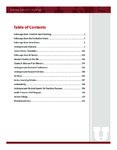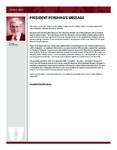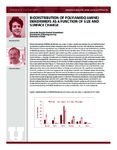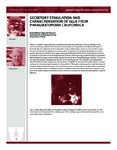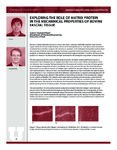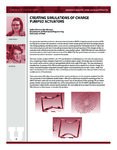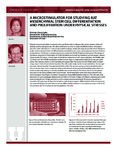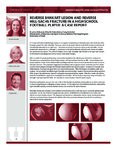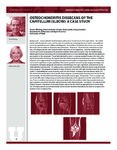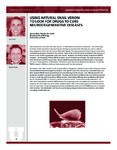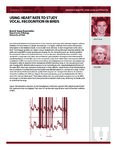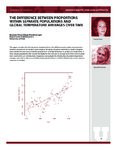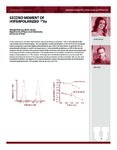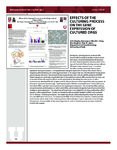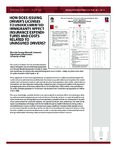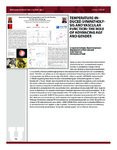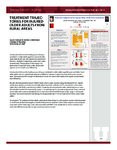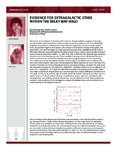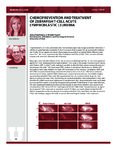| OCR Text |
Show 167 THE UNIVERSITY OF UTAH RESEARCH POSTERS ON THE HILL 2012 RETROSPECTIVE ANAL YSIS OF PATIENTS EX PERIENCING GYNECO LOGICAL CANCER IN CONJUNCTION WITH LIVER DYSFUNCTION James Lelis (Darren Johnson, Heather Thiesset, Greg Stoddard, Jason Schwartz) Department of General Surgery, Section of Transplantation University of Utah School of Medicine Raw data obtained from one animal for both the fasting and postprandial states. Mean Core Body Temperatures *significant difference between fasting and fed state ( P < 0.05) Alligator Mississippiensis natural Habitat-Florida Everglades) Habitat Thermo-Regulation in Alligator Mississippiensis Faisal Ahmed and C.G. Farmer Department of Biology Faisal Ahmed C.G. Farmer Initial Test Block Final Test Block Retrospective Analysis of Patients Experiencing Gynecological Cancer in Conjunction with Liver Dysfunction James Lelis1, Heather Thiesset, MPH2, Jason Schwartz, MD3,, John Sorensen, MD2, 1University of Utah Student, 2University of Utah Department of Surgery, Section of Transplantation, 3University of Texas, Southwestern, Department of Surgery, Division of Transplantation Background Results/Conclusions •CC. . The risk of gynecological cancers is dramatically increased in the setting of obesity, which has been estimated to affect up to 50% of the population. A component of the metabolic syndrome, obesity has been associated with fatty infiltration of the liver in up to 20% of individuals, leading to steatohepatitis and overt cirrhosis in the most severe cases. With surgery being the cornerstone of treatment in the case of gynecological malignancies, it is inevitable that surgeons will encounter patients with both diseases. Liver dysfunction compromises the body's ability to maintain hemostasis by disrupting the production of the majority of factors necessary for maintaining this delicate balance. Acid base disturbances also result from impaired liver function and contribute further to the overall deterioration of health. Given that the need for surgical intervention in gynecological cancer patients often conflicts with the high surgical morbidity known to exist in cirrhotics, the aim of this study was to reconcile these contradictions. Methods TNM Cancer Staging System References 1. Cancer Staging - National Cancer Institute . (n.d.). Comprehensive Cancer Information - National Cancer Institute . Retrieved July 6, 2011, from http://www.cancer.gov/cancertopics/factsheet/detection/staging ICD 9 Search Parameters of University of Utah HSC Patients After appropriate Institutional Review Board approval, patients were identified through ICD-9 codes by the University of Utah Health Sciences Enterprise Data warehouse team. A chart review was performed extracting data from laboratory values, clinical procedures, medical histories and survival outcomes. Using a matched 20:1 case/control design, patients were selected by type of malignancy, stage, gender, and age. Linear regression models and odds ratio analyses were performed. Demographics of Study Population Staging Diagnosis Description Stage 1: T = 1 In stage 1 cancer, the tumor is small and local. It has not yet spread to nearby tissue layers, the lymph nodes or other organs. N = 0 M = 0 Stage 2: T = 2-3 In stage 2 cancer, the tumor is larger and has spread to nearby tissue layers. It has not yet spread to the lymph nodes or other organs. N = 0 M = 0 Stage 3: T = 1-3 In stage 3, the cancer has spread to one or more lymph nodes but has not spread to other organs. The size of the tumor ranges from small (1) to large (3). N = 1-7+ M = 0 Stage 4: T = 1-3 In stage 4, the cancer has spread to one or more other organs. Lymph node involvement ranges from 0 to 7 nodes and the size of the tumor ranges from small (1) to large (3). N = 0-7+ M = 1+ Patients presenting with liver dysfunction exhibited a trend toward a more complicated hospital course. This was supported by (A) higher fresh-frozen plasma usage (an average of 10.46 units higher with P<0.001), (B) a longer average hospital stay (an average of 7.69 days longer with P<0.001), and (C) an increase in post-operative complications not associated with chemo- or radiation therapy (4.58 x higher with P=0.186). From these results, we concluded that that patients harboring evidence of cirrhosis or liver disease undergoing major gynecological procedures for oncologic indications are likely to incur a set of significant complications post-operatively. Because of this, it is incumbent upon clinicians to screen for the presence of these disorders so that complications can be mitigated. *Outcome of Mean Diff. Mixed Results Linear Regression Controlled for Procedure. *Outcome of Odds Ratio Mixed Results Linear Regression Controlled for Procedure. The TNM system is one of the most widely used staging systems. This system has been accepted by the International Union Against Cancer (UICC) and the American Joint Committee on Cancer (AJCC). Most medical facilities use the TNM system as their main method for cancer reporting. PDQ®, NCI's comprehensive cancer information database, also uses the TNM system. The TNM system is based on the extent of the tumor (T), the extent of spread to the lymph nodes (N), and the presence of distant metastasis (M). A number is added to each letter to indicate the size or extent of the primary tumor and the extent of cancer spread. - National Cancer Institute1 International Statistical Classification of Diseases and Related Health Problems Version 9 Codes Used to Identify Gynecological Cancer Patients. 182.1 MALIGNANT NEOPLASM OF ISTHMUS 183.8 MALIG NEOPLASM OTHER SPEC SITES UTERINE ADNEXA 180 MALIGNANT NEOPLSM OF CERVIX UTERI 182.8 MALIGNANT NEOPLASM OTHER SPEC SITES BODY UTERUS 183.9 MALIGNANT NEOPLASM UTERINE ADNEXA UNSPEC SITE 180.0 MALIGNANT NEOPLASM OF ENDOCERVIX 183 MALIGNANT NEOPLASM OF OVARY&OTHER UTERINE ADNEXA 571 CHRONIC LIVER DISEASE AND CIRRHOSIS 180.1 MALIGNANT NEOPLASM OF EXOCERVIX 183.0 MALIGNANT NEOPLASM OF OVARY 571.2 ALCOHOLIC CIRRHOSIS OF LIVER 180.8 MALIGNANT NEOPLASM OTHER SPECIFIED SITES CERVIX 183.2 MALIGNANT NEOPLASM OF FALLOPIAN TUBE 571.5 CIRRHOSIS OF LIVER WITHOUT MENTION OF ALCOHOL 180.9 MALIGNANT NEOPLASM CERVIX UTERI UNSPCIFIED SITE 183.3 MALIGNANT NEOPLASM OF BROAD LIGAMENT OF UTERUS 572.3 PORTAL HYPERTENSION 182 MALIGNANT NEOPLASM OF BODY OF UTERUS 183.4 MALIGNANT NEOPLASM OF PARAMETRIUM OF UTERUS 572.4 HEPATORENAL SYNDROME 182.0 MALIGNANT NEOPLASM CORPUS UTERI EXCEPT ISTHMUS 183.5 MALIGNANT NEOPLASM OF ROUND LIGAMENT OF UTERUS 782.4 JAUNDICE UNSPECIFIED NOT OF NEWBORN MeanDiff 95%Conf. Int. PValue HospitalStay 7.69Days 3.45to 11.92 <0.001 VentilatorDays 0.22Days -0.87to 1.32 0.69 ICUDays 2.03Days -0.23to 4.29 0.08 EstimatedBlood Loss 385mL 9.69to 760.49 0.04 PackedRedBlood Cells 9.72Units 7.00to 12.44 <0.001 FreshFrozenPlasma10.46Units8.11to 12.82 <0.001 Platelets 1.48Units 1.11to 1.84 <0.001 Cryoprecipitate 1.00Units 0.78to 1.22 <0.001 OddsRatio95%Conf. Int. PValue ComplicationsNot AssociatedWith Chemo.OrRadiation 4.58 0.48to 43.70 0.19 James Lelis John Sorensen, MD The risk of gynecological cancers is dramatically increased in the setting of obesity, which has been estimated to a ect up to 50% of the population. A component of the metabolic syndrome, obesity has been associated with fatty in ltration of the liver in up to 20% of individuals, leading to steatohepatitis and overt cirrhosis in the most severe cases. With surgery being the cornerstone of treatment in the case of gynecological malignancies, it is inevitable that surgeons will encounter patients with both diseases. Given that the need for surgical intervention in these patients often con icts with the high surgical morbidity known to exist in cirrhotics, the aim of this study was to reconcile these contradictions. After appropriate Institutional Review Board approval, patients were identi ed through the International Statistical Classi cation of Diseases and Related Health Problems version 9 codes (Table 1) by the University of Utah Health Sciences Enterprise Data warehouse team. Parameters used were types of surgical procedures used to treat the gynecological malignancies. Although a small sample size was used, its rigorous control methods strengthened the validity of the conclusions. Patients presenting with liver dysfunction exhibited a trend toward a more complicated hospital course (Table 2). This was supported by (A) higher fresh-frozen plasma usage (an average of 10.46 units higher with P<0.001), (B) a longer average hospital stay (an average of 7.69 days longer with P<0.001), and (C) an increase in post-operative complications not associated with chemo- or radiation therapy (4.58 x higher with P=0.186). From these results, we concluded that that patients harboring evidence of cirrhosis or liver disease undergoing major gynecological procedures for oncologic indications are likely to incur a set of signi cant complications post-operatively. Because of this, it is incumbent upon clinicians to screen for the presence of these disorders so that complications can be mitigated. |

